
Year 1227 (MCCXXVII) was a common year starting on Friday of the Julian calendar.
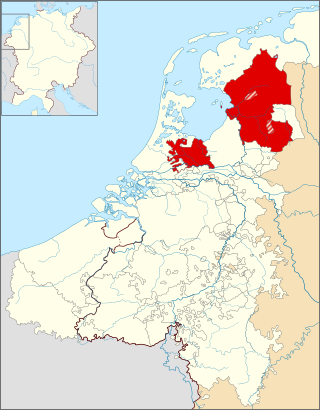
The Bishopric of Utrecht was an ecclesiastical principality of the Holy Roman Empire in the Low Countries, in the present-day Netherlands. From 1024 to 1528, as one of the prince-bishoprics of the Holy Roman Empire, it was ruled by the bishops of Utrecht.

Otto of Lippe was a son of Bernhard II, Lord of Lippe. He was bishop of Utrecht as Otto II from 1216 to 1227. Several of his brothers also held high ecclesiastical offices in the Rhineland. He likely participated in the foundation of the Teutonic Order.

Gramsbergen is a small Dutch city on the Vechte, located in the municipality of Hardenberg and the province of Overijssel. The town is located on corridors of different transportation modes: The N34, the Zwolle - Emmen railway and the Almelo - de Haandrik canal.

The Prince-Bishopric of Münster was a large ecclesiastical principality in the Holy Roman Empire, located in the northern part of today's North Rhine-Westphalia and western Lower Saxony. From the sixteenth to the eighteenth centuries, it was often held in personal union with one or more of the nearby ecclesiastical principalities of Cologne, Paderborn, Osnabrück, Hildesheim, and Liège.
The Drenther Crusade was a military campaign launched against the inhabitants of Drenthe with the approval of the Papacy in 1228 and lasting until 1232. It was led by Willibrand, Bishop of Utrecht, commanding an army composed mostly of Frisian crusaders.
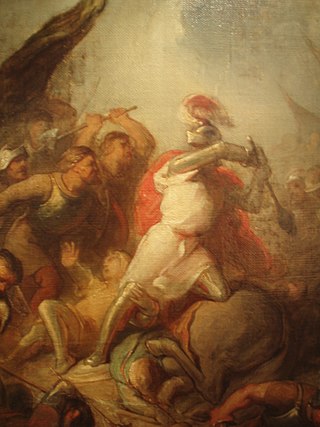
The Battle of Ane, was fought in 1227 between Otto II of Lippe, Bishop of Utrecht, and Rudolf II van Coevorden with his army of Drenths. The account of the battle comes from Quedam narracio de Groninghe de Trentis de Covordia et diversis aliis sub episcopis traiectensibus, a manuscript from the early 13th century.
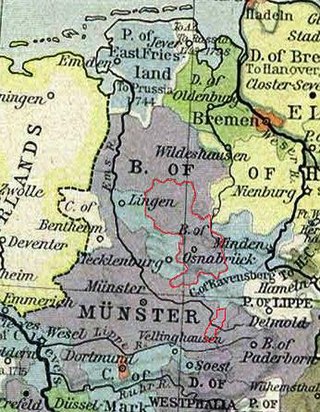
The Prince-Bishopric of Osnabrück) was an ecclesiastical principality of the Holy Roman Empire from 1225 until 1803. It should not be confused with the Diocese of Osnabrück, which was larger and over which the prince-bishop exercised only the spiritual authority of an ordinary bishop. It was named after its capital, Osnabrück.

The Prince-Bishopric of Paderborn was an ecclesiastical principality (Hochstift) of the Holy Roman Empire from 1281 to 1802.
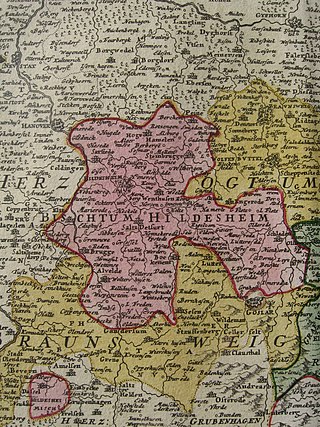
The Prince-Bishopric of Hildesheim was an ecclesiastical principality of the Holy Roman Empire from the Middle Ages until its dissolution in 1803. The Prince-Bishopric must not be confused with the Diocese of Hildesheim, which was larger and over which the prince-bishop exercised only the spiritual authority of an ordinary bishop.

Prince-provost is a rare title for a monastic superior with the ecclesiastical style of provost who is also a Prince of the Holy Roman Empire (Reichsfürst), holding a direct vote in the Imperial Diet assembly coequal to an actual Prince-abbot, as in each case treated below.
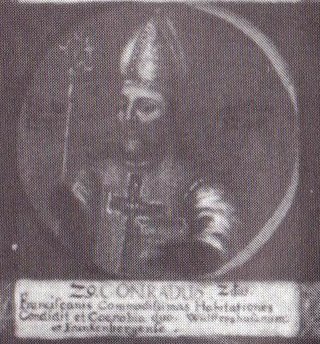
Conrad II of Reifenberg was Bishop of Hildesheim from 1221 to 1246. During his tenure, the Bishopric of Hildesheim was raised to an Imperial State (Hochstift), when Conrad was vested with secular rights of a prince-bishop by Emperor Frederick II in 1235.
Floris van Wevelinkhoven was Bishop of Münster from 1364 to 1379 and Bishop of Utrecht from 1379 to 1393.
Simon I, Count of Tecklenburg was Count of Tecklenburg from 1156 until his death.
Eric I, Count of Hoya (1370-1426) was a German nobleman. He was the ruling Count of Upper Hoya from 1377 until his death.
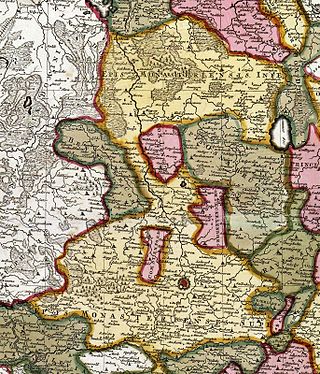
The Münster Diocesan Feud, or simply Münster Feud, was a dispute that took place between 1450 and 1457 over the appointment to the bishop's throne in Münster, and hence the rule of the diocese. The cause was the death of the previous prince-bishop, Henry II of Moers. The opposing candidates were his brother Walram of Moers, Eric of Hoya, and Conrad of Diepholz. They were supported by their families with Count John of Hoya, Archbishop Dietrich II of Moers and Prince-Bishop Rudolf of Diepholz at their respective heads. In addition, there were also external allies. Within the diocese the Stände, namely the cathedral chapter and the town of Münster, played an independent role at times. In the end neither candidate was able to succeed to the office.

Rudolph van Coevorden was a feudal lord of the Drenthe who led a rebellion against Otto II, Bishop of Utrecht. He defeated and killed Otto at the Battle of Ane in 1228. Otto's successor, Wilbrand, initiated a crusade against the Drenthers. During a truce in 1230, Rudolph was arrested at a meeting in Hardenberg and executed.

The Stedinger Crusade (1233–1234) was a Papally-sanctioned war against the rebellious peasants of Stedingen.

Bruno of Altena-Isenberg, known as Bruno of Isenberg, was Prince-Bishop of Osnabrück from 1250 to his death. He succeeded his brother Engelbert III as Prince-Bishop.














